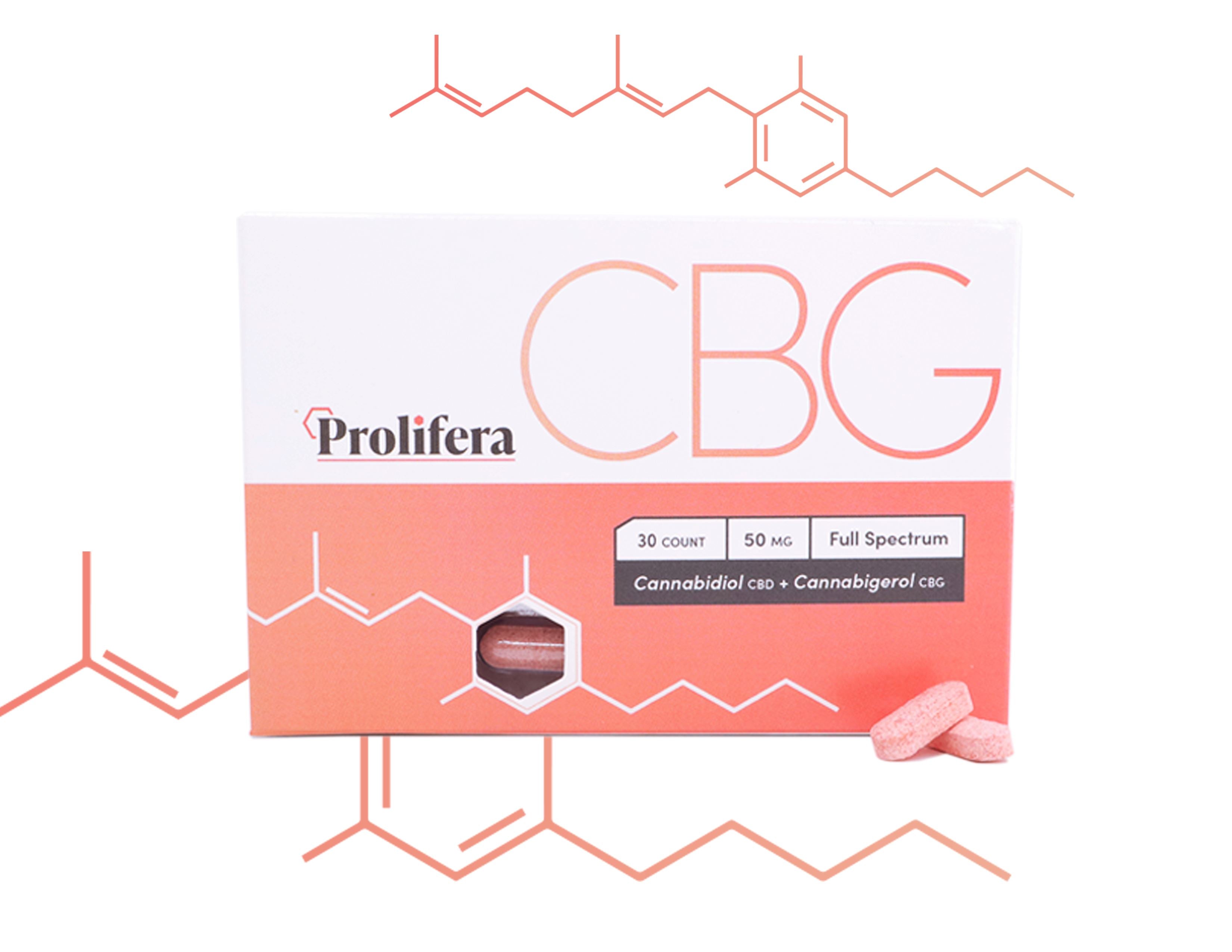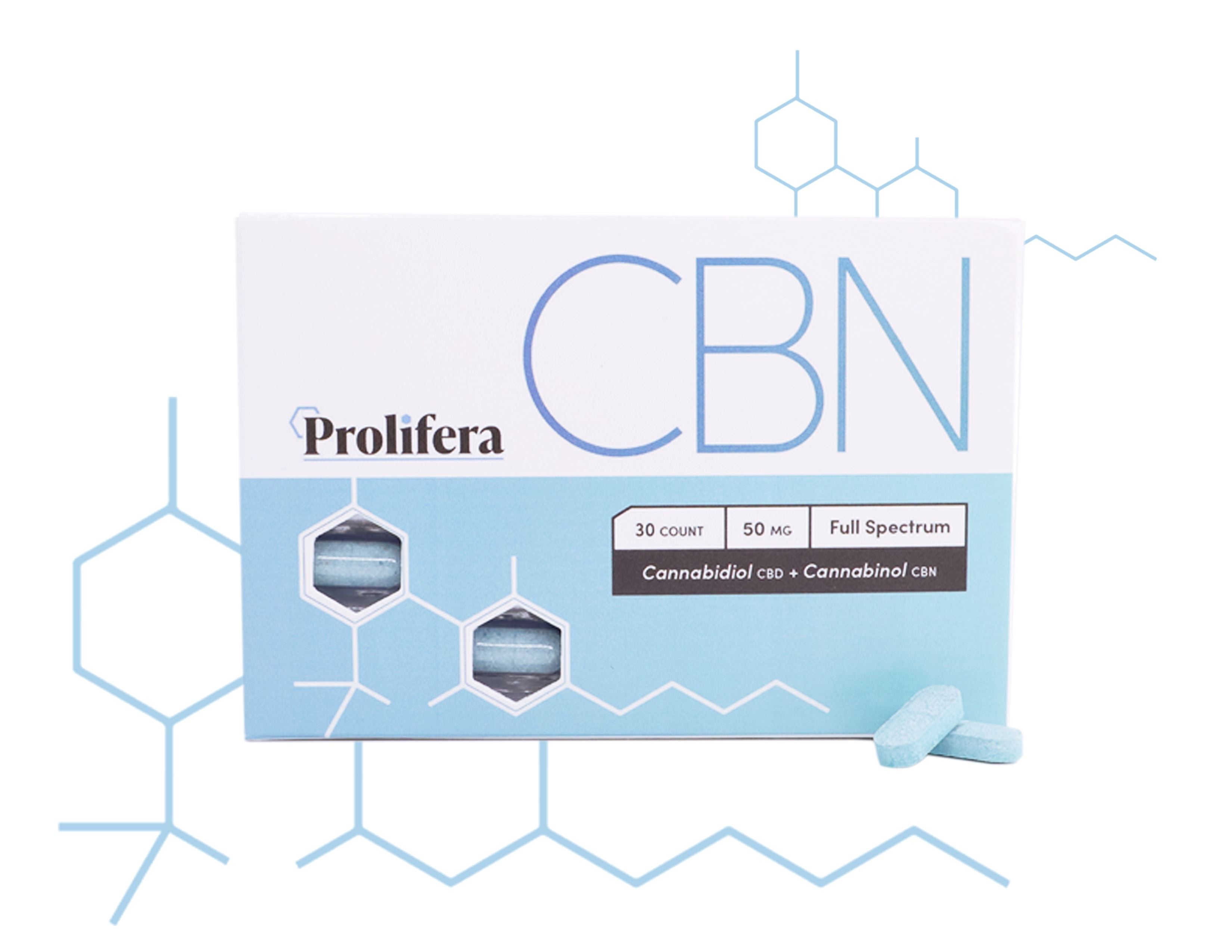CBG: The Mother Cannabinoid

Cannabigerol (CBG) is often referred to as the mother of all cannabinoids, although it still remains one of the lesser-known cannabinoids. Others coin it as the "stem cell of cannabinoids" due to its metamorphic properties. Cannabigerolic acid (CBGA) is the acidic form of CBG and is the precursor to many other cannabinoids such as Cannabidiol (CBD), Cannabichromene (CBC), and Tetrahydrocannabinol (THC). These chemical pathways in the living plant produce the fledgling cannabinoids, leaving little CBGA to form into CBG.
Consumer products derived from CBG are often more expensive to produce than other cannabinoids like CBD and THC. Due to the smaller quantities found in mature cannabis plants, more plant material is needed and specialized processing equipment for its production. Full-spectrum or broad-spectrum products may contain smaller amounts, but isolated CBG products are more difficult to obtain.
CBG is typically most abundant in low-THC and high-CBD cannabis strains, including hemp. Consumption of CBG will not cause any type of euphoric effects, making it an acceptable alternative in states where legal access to marijuana is limited. The demand for CBG is growing in popularity due to the many potential health benefits the cannabinoid has to offer.
Plant Production of CBG
CBG is one of more than 100 cannabinoids native to the cannabis plant and found in both hemp and marijuana. Geranyl pyrophosphate and olivetolic acid combine in the plants' trichomes which are the small spheres of cannabis resin that coat the buds and produce CBGA. This precursor of CBG performs an important protective function for cannabis and directs the plant's energy toward the flower. It accomplishes this by a targeted triggering of plant cell necrosis (death) to naturally "prune" the plant. CBGA, the acidic form of CBG, is the foundational compound from which other cannabinoids are synthesized. Hence, the reference to it as the "mother cannabinoid."
The conversion via chemical pathways of the CBGA during the plant maturation leads to high concentrations of other acidic cannabinoids such as; tetrahydrocannabinolic acid (THCA) and cannabidiolic acid (CBDA), and cannabichromenic acid (CBCA). CBGA also naturally breaks down to CBG in the plant's growth or exposure to heat, UV, and light. Decarboxylation is the name for this aging or heating process required for this conversion into CBG, resulting in maximum therapeutic value.
As mentioned previously, CBG is typically most abundant in low-THC and high-CBD cannabis strains. CBG's concentration in fully developed plants is very low, usually less than 1 percent in marijuana and less than 2 percent in hemp. Younger cannabis plants contain higher concentrations of CBG. Its levels are highest in the budding plants because the CBGA is yet to be converted into the other compounds. Cannabis researchers and growers are trying to find ways to produce high CBG strains via genetic modification or selective breeding to produce plants with significant levels of this valuable cannabinoid.
In Our Bodies
Our endocannabinoid system (ECS) is a naturally occurring and complex signaling network responsible for keeping many of the body’s functions in balance. Plant cannabinoids (phytocannabinoids) act within our ECS receptors, CB1 and CB2. They accomplish this by mimicking our body’s endocannabinoids with a similar chemical makeup which synthesize naturally in our system and binding like a lock and key with the receptors.
CBG has been found to act as a low-affinity CB1 antagonist, meaning it can minimize the receptor’s associated biological response by partially binding with and blocking it in addition to binding to CB2 receptors. CBG has also been shown to increase anandamide levels, one of the body's endocannabinoids that ensures the ECS efficiency and regulates biological functions like sleep, memory, pain sensations, and appetite. CBG accomplishes this by inhibiting the enzymes that break down anandamide to increase bioavailability for the ECS to utilize.
The ECS isn’t the only network CBG appears to influence. CBG has also acted as an agonist of 5-HT1A receptors, which manage the neurotransmitter serotonin's release. CBG has also been found in animal models to inhibit GABA uptake, which causes a feeling of relaxation. CBG seems to be a potent agonist of the alpha-2 adrenergic receptor. There is excellent potential for further research in this area as pharmaceutical therapies targeting that receptor treats a wide variety of ailments which include; opiate withdrawal, hypertension, anxiety, pain, and ADHD. CBG acts as an agonist, binding and activating the receptors to influence norepinephrine and epinephrine release potentially.
Potential Health Benefits
Anecdotal evidence suggests that CBG acts as a buffer to the psychoactivity of THC by working to mitigate the paranoia that one may feel with higher doses. It may also accelerate the effects of other cannabinoids by creating the entourage effect, and proponents believe it will become a new trend in cannabis wellness. Initial animal research has shown that it has a wide range of potential applications to improve human health.
Inflammatory Bowel Disease (IBD)
Inflammatory bowel disease is an incurable condition that causes chronic inflammation in the bowel, affecting millions of people. This animal study has shown that CBG reduced inflammation, nitric oxide production, and reactive oxygen species in the colons. They concluded that CBG should be considered for clinical experimentation in IBD patients.
Glaucoma
Endocannabinoid receptors are highly concentrated in the eye structures, explaining why cannabinoid treatment may be so useful. In this animal study, researchers found that CBG has therapeutic potential for glaucoma treatment, one of the leading causes of blindness globally. They administered CBG to cats with glaucoma and noticed a reduction in eye pressure and an increase in aqueous humor outflow, a fluid produced by the eye which maintains eye pressure and provides the eye with nutrition. The study also found that, unlike THC, CBG did not affect certain phases of sleep. A different meta-analysis of available research has also shown that CBG is particularly effective with lowering intraocular pressure.
Neurodegenerative Diseases
CBG acts as a neuroprotectant, protecting the nerve cells in your brain from damage. Huntington’s, Alzheimer’s, and Parkinson's are neurodegenerative diseases that CBG shows promise in treating based on initial test tube research. Add to the mix that pathological conditions such as inflammation and oxidative stress also play a role in these neurodegenerative diseases, which the introduction of CBG may even improve.
Huntington's disease is a condition that causes a breakdown of nerve cells in the brain. Researchers examined the potential neuroprotective properties of CBG and other cannabinoids in mice who had an experimental model of Huntington’s disease. Researchers treated the mice with 3-nitropropionic acid because it produces striatal lesions reminiscent of Huntington's disease. It was observed that CBG improves motor deficits and preserves striatal neurons against 3-nitropropionic acid toxicity.
Antibacterial
Two separate studies involved various methicillin-resistant Staphylococcus aureus (MRSA) strains and the clinical relevance of CBG. This 2008 study showed when CBC was applied topically, and it actively worked against resistant bacteria strains. A 2020 study on mice on the antibiotic potential of cannabis also demonstrated that CBG has the ability to target the cytoplasmic membrane of gram-positive bacteria. Once again, it showed efficacy in fighting MRSA, a drug-resistant bacteria which causes staph infections.
Cancer-Fighting Properties
According to the American Cancer Society, colorectal cancer is the third most common cancer diagnosed in both men and women in the United States. In a 2014 study, researchers observed the effects of CBG on mice with colon cancer. They observed that CBG showed some promise in blocking the receptors that cause cancer cell growth and inhibiting the growth of colorectal cancer cells. Researchers proposed that the use of CBG should be considered translationally in the cure and prevention of colon cancer. Clinical research in the future will offer significant insights into the potential for human cancer treatments.
A 2020 systematic review confirms the potential use of CBG as an anti-cancer agent. Researchers demonstrated that CBG showed potential as antineoplastic agents on experimental models. They can reduce tumor volume and formation of cells that are aberrant or do not work correctly. However, they suggest that it is crucial to conduct more experimental studies to glean further details on the pharmacology of CBG.
Conclusion
CBG is non-psychotropic and has a promising wide range of potential health and wellness applications. The published animal studies indicate that more research is needed to fully understand how CBG works in the human body. Not much is known about its side effects. CBG may also lower blood pressure, and it might interact with certain medications. It is wise to discuss its use with your doctor and err on the side of caution, especially if you have underlying health conditions. The Food and Drug Administration (FDA) does not regulate CBG and other cannabinoids, so it is best to ensure you're getting a high-quality product by purchasing from a reputable company that provides lab reports on their products.
CBG interacts with the CB1 and CB2 receptors in the body to increase anandamide, known as the “Bliss Molecule” and can help stimulate appetite, enhance sleep, lift mood and supports the immune system to help your body fight off illness. “Unlike CBD, which has a relatively low affinity for cannabinoid receptors and acts mostly through indirect interactions with the endocannabinoid system, CBG is thought to elicit its therapeutic effects directly though interaction with the CB1 and CB2 cannabinoid receptors in the brain."
Studies have also shown CBG to have anti-bacterial and anti-microbial effects while at the same time promotes neuroprotective activity in the brain. “Much like CBD, CBG is also an appetite stimulant that has even been shown to enhance the death process in cancer cells." More research is underway to understand more about CBG and back these claims.
Hemp farmers can now grow plants that are high in CBG to allow extractors to bring more diverse cannabis products to the market. The price for CBG can be 5-6 times higher than that of CBD but that will change over the next few years. There are several pioneering companies that have CBG available because of its promising future in the world of cannabis.
Written by Judy Ghanem, Prolifera Content Writer.





1 comment
What a great, highly-informative article! I didn’t know CBG had so many potential health benefits. I will definitely be looking into this for my arthritis. Thanks.
Jim
Leave a comment
This site is protected by hCaptcha and the hCaptcha Privacy Policy and Terms of Service apply.